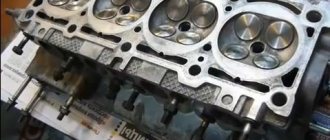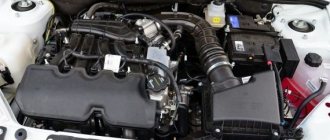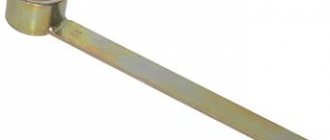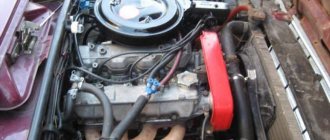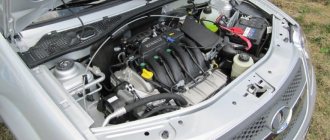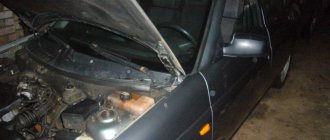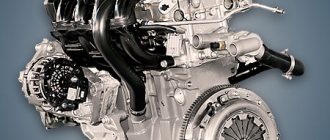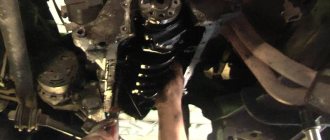8 valve engine design
Such engines are used mainly on models in the entry-level price segment. Here there are 2 valves per cylinder: 1 for intake and 1 for exhaust.
Another important feature of such power plants is that only 1 camshaft is needed, which controls the gasoline injection and exhaust gas exhaust system. To operate it, a simple belt or chain mechanism is sufficient. Such a system is much easier to maintain and repair compared to complex timing belts of more expensive cars. And such an elementary design significantly affects the final cost of the car.
As an example, we give a diagram of the design of an 8-valve VAZ-2114 engine.
1) generator drive pulley; 2) oil pump; 3) timing belt; 4) coolant pump timing belt; 5) front cover of the timing mechanism drive; 6) tension roller; 7) camshaft toothed pulley; camshaft drive rear cover; 9) camshaft oil seal; 10) cylinder head cover; 11) camshaft; 12) front camshaft bearing cover;
2) oil pump; 3) timing belt; 4) coolant pump timing belt; 5) front cover of the timing mechanism drive; 6) tension roller; 7) camshaft toothed pulley; camshaft drive rear cover; 9) camshaft oil seal; 10) cylinder head cover; 11) camshaft; 12) front camshaft bearing cover;
13) pusher; 14) valve guide; 15) oil separator mesh for the crankcase ventilation system; 16) exhaust valve; 17) inlet valve; 18) rear camshaft bearing cover; 19) fuel pump; 20) housing of auxiliary units; 21) ignition distributor sensor; 22) cooling jacket outlet pipe; 23) cylinder head; 24) spark plug; 25) crankcase ventilation hose;
26) flywheel; 26) flywheel; 27) crankshaft rear oil seal holder; 28) rear crankshaft oil seal; 29) cylinder block; 30) oil pan; 31) oil level indicator (oil dipstick); 32) crankshaft; 33) piston; 34) connecting rod cover; 35) connecting rod; 36) crankshaft main bearing cover; 37) front crankshaft oil seal; 38) crankshaft toothed pulley.
Pros and cons of an 8 valve engine
This engine design, despite its venerable age, has many advantages:
- simplicity of design - an 8-valve engine has significantly fewer wearing parts, and accordingly, its repair will be easier and cheaper;
- lack of hydraulic compensators - motors of this type simply do not need them, so the design is further simplified and cheaper;
- less demanding on oil characteristics - 8-valve engines allow the use of lower quality lubricant, which is noticeably cheaper;
- less sensitivity to the quality of gasoline - most of the 8-valve valves used today were developed at a time when there was no better fuel than 92;
- small size - one camshaft takes up much less space, so such engines are more compact than their 16-valve counterparts, and this makes access to attachments easier.
However, there are also many significant disadvantages:
- less power - intake and exhaust through 2 valves significantly limits the amount of fuel supplied to the cylinders and the total engine power;
- slightly higher fuel consumption - the reduced throughput of 1 pair of valves forces the engine to put more effort into pushing exhaust gases into the manifold, and accordingly more energy is spent on this;
- noise at high speeds - the pushers wear out during engine operation, gaps form, which is why the engine begins to make noticeable noise;
- the need for more frequent valve adjustments - if this is ignored, engine performance will drop, and fuel consumption, on the contrary, will increase.
Engine design
To get an answer to the question, which engine for a VAZ, Renault, Kalina or other car brand is better and why you need to study their design and know the principle of operation. Based on the results obtained, it is possible to identify all the advantages and disadvantages of each model and conduct a comparative analysis of them.
8 valve engine
The design of the 8-valve engine is considered traditional. It consists of the following main components:
- Cylinder block. Engines of this arrangement include four cylinders, which are arranged sequentially in one row.
- Valves. The eight-valve system got its name due to the location of two valves in one cylinder: an inlet for injecting the fuel mixture into the cylinder and an outlet for exhaust gases. They are located at the top of the piston chamber.
- Camshaft (camshaft). It opens the corresponding valve in the cylinder at the right time. Accordingly, the main task of this part is to regulate the opening and closing of valves due to the presence of cams (eccentrics) on it.
For an 8-valve engine there are no restrictions on the quality of engine oil
The principle of operation is to inject the fuel mixture through the intake channel and at the moment of maximum compression ratio of the fuel by the piston, it ignites due to the formation of a spark. The released energy is transmitted through a system of mechanisms to the wheel group.
16 valve engine
The basic layout of this type of engine is somewhat different from the traditional design. These differences lie in the following main components of the motor:
- Cylinder block. The arrangement of the cylinders and their number remain the same as in the standard version. That is, four pistons arranged in one row.
- Valves. This node is one of the main differences. In this type of internal combustion engine (ICE), the valves are made in pairs. Each cylinder has two intake and two exhaust valves, a total of 4 for one “boiler” and 16 for the entire engine.
- Camshaft. In this power unit, to adjust the valves, i.e. For their timely opening and closing, two camshafts are used. Structurally, they are made similar to the one installed in the 8-valve unit.
The operating principle of a 16-valve internal combustion engine is similar to the previous type. The exception is that the fuel mixture is supplied through two intake valves, and exhaust gases are discharged through two exhaust valves.
Having studied the main components of the two types of engines, it is possible to conduct a comparative analysis of these two mechanisms.
Engine camshaft
Comparison of two types of engines
To compare and determine the best layout, we will select engines of the same volume. As the subject of analysis, we will choose, for example, a 1.6-liter power unit installed on a VAZ. For a better understanding, the results of comparison of technical characteristics are presented in the form of a table below:
| Technical specifications | V8 | V16 |
| Maximum power, kW/l. With. | 59,5 / 81 | 66 / 90 |
| Maximum torque, N*m | 120 | 131 |
| Acceleration time to 100 km/h, sec. | 13,2 | 11,2 |
| Maximum speed, km/h | 160 | 190 |
| Brake disc size, inch | 13 | 14 |
| Ventilated cavity | No | There is |
As can be seen from a comparative analysis of two engines of the same volume, but different layouts, the V16 version is faster and has more power.
Attention! The increase in traction force entailed the installation of larger brake discs with a modified design (the presence of ventilation for cooling).
Advantages of an 8-valve engine
By comparing these two types of power units and studying the design, you can determine their advantages and disadvantages. The advantages of an 8-valve engine include:
- Broken timing belt. In cases where the belt breaks, the valves do not bend.
- Oil. During operation, there are no strict restrictions on the quality of engine oil.
- Availability during renovation. The small dimensions of the power plant provide easy access to different places and to any mechanisms of the car and engine.
- Torque. The 8-valve engine type is capable of producing fairly high torque at low engine speeds.
Flaws
The traditional scheme has few disadvantages of its layout. Main disadvantages:
- Noise and vibration. An outdated engine model has high noise and vibration during operation.
- Thermal clearances. After the service life established by the manufacturer, the power unit requires adjustment of the thermal clearances.
- Timing belt. The engine requires periodic adjustment of the timing belt.
Attention! Adjusting thermal clearances requires high precision. It is easy to make mistakes during a manual operation.
Advantages of a 16 valve engine
Like all units, this type of engine has its advantages and disadvantages. Benefits include:
- Noise. Has improved sound insulation. Accordingly, during its operation the noise level is several times lower than that of its 8-valve counterpart.
- Thermal clearances. The improved motor design does not require periodic adjustment of thermal clearances.
- Power. The maximum power developed by this unit is an order of magnitude higher than that of the previous type.
- Speed. Develops a high maximum speed and is well suited to high-speed driving.
The 16-valve engine is well suited to high-speed driving
Flaws
Among the disadvantages are the following:
- Broken timing belt. In cases where the timing belt breaks, the valves bend, which is associated with large capital investments in repairs.
- Bulky. The impressive size of the units limits access to the unit being repaired.
- Engine oil. The presence of hydraulic compensators places high demands on the quality of engine oil. The use of low-quality lubricants leads to coking of hydraulic compensators and their premature replacement.
- Torque. At low speeds the engine has insufficient torque.
16 valve engine design
In such 4-cylinder engines, each cylinder already has 2 pairs of intake and exhaust valves. To operate such a system, 2 camshafts are required. And for their coordinated work, a much more complex gas distribution mechanism is used. At the same time, 2 intake valves allow more fuel to be supplied to the cylinders per stroke - and hence a significant increase in power and efficiency. At the same time, fuel consumption is reduced thanks to the presence of 2 exhaust valves.
Hydraulic compensators are often used to press the valves against the shaft in such engines. Unlike 8-valve valves with mechanical pushrods, this system operates smoother and quieter. It also provides an additional increase in power and additional fuel economy.
Another specific feature of 16-valve engines, which becomes especially relevant against the backdrop of ever-tightening environmental requirements, such engines, due to more precise operation of the gas distribution mechanism, are safer for the environment.
For example, here is a diagram of the design of a 16 valve VAZ 2112 engine.
1) engine oil pan; 2) front crankshaft oil seal; 3) crankshaft; 4) crankshaft pulley; 5) oil pump; 6) generator drive pulley; 7) timing belt; front cover of the timing mechanism drive; 9) coolant pump pulley (pump); 10) tension roller; 11) camshaft toothed pulley; 12) rear cover of the timing mechanism drive; 13) camshaft oil seal;
2) front crankshaft oil seal; 3) crankshaft; 4) crankshaft pulley; 5) oil pump; 6) generator drive pulley; 7) timing belt; front cover of the timing mechanism drive; 9) coolant pump pulley (pump); 10) tension roller; 11) camshaft toothed pulley; 12) rear cover of the timing mechanism drive; 13) camshaft oil seal;
14) exhaust camshaft; 15) hydraulic pusher; 16) valve spring; 17) valve guide; 18) exhaust valve; 19) receiver; 20) camshaft bearing cover; 21) guide pipe; 22) cylinder head cover; 23) plastic cover; 24) spark plug; 25) intake camshaft; 26) inlet valve; 27) cylinder head; 28) coupling;
29) fuel rail; 30) crankcase ventilation hose; 31) nozzle; 32) intake manifold; 33) flywheel; 34) crankshaft rear oil seal holder; 35) rear crankshaft oil seal; 36) cylinder block; 37) oil dipstick; 38) piston; 39) connecting rod; 40) connecting rod cover; 41) crankshaft main bearing cover.
Technical specifications
Let's consider the technical characteristics of 8 and 16 valve engines using the example of VAZ models.
Similar article Design and principle of operation of an internal combustion engine
| Technical specifications | VAZ 21116 | VAZ 21126 |
| Number of cylinders | 4 | 4 |
| Number of valves | 8 | 16 |
| Volume, cm3 | 1596 | 1597 |
| Cylinder diameter, mm | 82 | |
| Piston stroke, mm | 75,6 | |
| Compression ratio | 10,5 | 11,0 |
| Power, hp at rpm | 87/5100 | 98/5600 |
| Torque, Nm at rpm | 140/3800 | 145/4000 |
| Petrol | AI-95 | |
| Mixed consumption, l/100 km | 7,3 | 7,0 |
What is better, an 8 or 16 valve engine? According to technical indicators, the 16-valve engine wins in power and efficiency, but it is worth taking into account the costs that will have to be incurred for using dynamics and comfort.
When buying a car aftermarket, you can distinguish a 16-valve engine by its appearance. The engine's wide intake manifold resembles a snail, and is usually covered by a shroud with the company logo and the inscription 16Valve.
Pros and cons of a 16 valve engine
So, here are the main advantages of 4-cylinder engines with 16 valves:
- significant increase in power, increased maximum speed and dynamics;
- lower fuel consumption and environmental friendliness;
- much lower noise level;
As you can see, the advantages of such engines are significant. But they also have significant disadvantages:
- hydraulic compensators are very sensitive to oil quality, it is recommended to use only synthetic oil;
- for efficient operation of the “four” with 16 valves, you need high-quality gasoline, ideally not lower than AI-95;
- Structurally, such engines are much more complex, in particular, replacing the timing belt here, as a rule, costs several tens of thousands of rubles;
- The motor itself is larger, which makes access to attachments more difficult.
Main differences between 16 and 8 valve engines
We have figured out the features of these types of engines, now we will specify the differences between them.
8-valve engines are much simpler in design, which has a positive effect on the price of the entire car, its maintenance and repairs. However, they are significantly inferior in power to 16-valve analogues with the same displacement - on average, the difference in power here is 15-25 hp. Because of this, engine response, acceleration dynamics, and maximum speed suffer.
At the same time, 4-cylinder engines with 8 valves are much simpler and more affordable to repair. There are significantly fewer elements that can break, and if something does break down, the breakdown can be repaired with less effort. And spare parts for such engines are usually cheaper.
With efficiency, everything is not so clear. Yes, 8-valve engines consume more fuel - but at the same time, they can be filled with lower quality, inexpensive gasoline. Oil may not be the most expensive either. Another controversial point is the use of hydraulic compensators. They are installed on 16-valve engines and eliminate the need for systematic valve adjustment. At the same time, they sometimes fail, and replacing them will cost a pretty penny.
One more important point should also be noted: in 16-valve engines, the piston and valves can jam together - and this inevitably leads to costly repairs, and sometimes to a complete replacement of the engine. In principle, 8-valve patients do not have such a disease. However, such jamming occurs, as a rule, on Russian and Chinese cars, which by default are inferior to the Western and Japanese automobile industry.
Consumer characteristics
In addition to power and efficiency, the engine is evaluated in terms of repair and maintenance costs. The ability to improve the performance of the motor also increases its “value”. For example, to increase the engine displacement, the cylinders are bored or the piston stroke is increased.
Repair work
Any engine experiences high load during aggressive driving. Whether it's an 8 or 16 valve engine. Even with proper operation, the power unit has resource limitations. Many of the parts involved wear out and need to be replaced. Frequent problems:
- floating or high idle speed. During diagnostics, the mass air flow sensors, idle air control and throttle valve are checked;
- overheating of the engine may be due to a faulty thermostat, lack of coolant or contamination of the radiator;
- clogged injectors or old spark plugs can cause engine vibration;
- Electrical failures often occur on domestic engines;
- knocking noises under the hood indicate faulty hydraulic lifters, unadjusted pushers or a damaged connecting rod and piston group.
If the engine is equipped with push-in pistons, without grooves on the bottom, a broken timing belt causes the valve stems to bend. To avoid the problem, you need to install a high-quality belt and check its condition every 15,000 km. A safer option is to replace the pistons with non-stick ones.
A drop in compression or an increased appetite for oil is already a reason for a major overhaul, but in practice this happens after 200,000 km. The difference in the cost of major repairs of 8 and 16 valve VAZ engines is 5 - 10 thousand rubles. The average price for a complete overhaul is 8kl. — 35,000 rub.
Similar article Technical characteristics of the ZMZ 402 engine
Tuning
Engines are tuned to achieve better performance, both 8 and 16 valve units. To achieve high-torque performance of the car, the engine displacement is “increased”:
- Bore the cylinders or increase their number.
- Increase piston stroke.
The most popular method is cylinder boring. However, cutting more than 3 mm from the original size may result in thinning of the walls. This reduces the service life of the part and leads to leaks.
Other tuning options:
- Increasing the number of valves.
- Installation of a sports camshaft for increased power and efficiency.
- Increasing the volume of the exhaust receiver to stabilize the engine.
- Replacing the air filter with a zero filter to increase the amount of incoming air.
- Turbocharged engine.
Which is better 16 valves or 8
So, let's try to determine which option and in which situation will still be preferable. New cars with 4-cylinder engines offered in showrooms are almost always equipped exclusively with 16-valve engines; such engines have already displaced the outdated 8-valve design from the market. However, some manufacturers, usually from the lower price segment, still have such simplified options. Their main advantage is just a more affordable price.
But, if you have the opportunity to pay extra, the car is chosen for personal, not commercial use, and you are not going to service it yourself, then it would be more reasonable to buy a car with a 16-valve engine. It will delight you with higher power and dynamics, as well as efficiency and reduced noise.
In a situation where the car is taken from hand, 8-valve options may be preferable. The fact is that they are structurally simpler and more unpretentious in the choice of fuel and oil, respectively, here the chance of getting a car with a “live” and peppy engine will be higher than in the case of more sensitive 16-valve engines.
It is impossible to say unequivocally which option is better. It is necessary, first of all, to take into account your own goals and objectives, financial capabilities, and the conditions in which the car will be operated. If your primary requirements are reliability and unpretentiousness, then it makes sense to take a closer look at the 8-valve modifications. If speed and power are important to you, then it is better to choose 16-valve engines.
